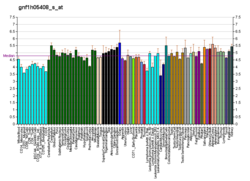| OR52B2 |
|---|
|
| Identifiers |
|---|
| Aliases | OR52B2, OR11-70, olfactory receptor family 52 subfamily B member 2 |
|---|
| External IDs | MGI: 3030525; HomoloGene: 17483; GeneCards: OR52B2; OMA:OR52B2 - orthologs |
|---|
| Gene location (Human) |
|---|
 | | Chr. | Chromosome 11 (human)[1] |
|---|
| | Band | 11p15.4 | Start | 6,169,355 bp[1] |
|---|
| End | 6,170,326 bp[1] |
|---|
|
| Gene location (Mouse) |
|---|
 | | Chr. | Chromosome 7 (mouse)[2] |
|---|
| | Band | 7|7 E3 | Start | 104,984,716 bp[2] |
|---|
| End | 104,991,477 bp[2] |
|---|
|
| RNA expression pattern |
|---|
| Bgee | | Human | Mouse (ortholog) |
|---|
| | Top expressed in | - respiratory epithelium
- nasal epithelium
- olfactory epithelium
- embryo
- superior frontal gyrus
- striatum of neuraxis
- hypothalamus
|
| | More reference expression data |
|
|---|
| BioGPS | 
 | | More reference expression data |
|
|---|
|
| Gene ontology |
|---|
| Molecular function | - G protein-coupled receptor activity
- olfactory receptor activity
- signal transducer activity
| | Cellular component | - integral component of membrane
- plasma membrane
- membrane
| | Biological process | - sensory perception of smell
- signal transduction
- response to stimulus
- detection of chemical stimulus involved in sensory perception of smell
- G protein-coupled receptor signaling pathway
| | Sources:Amigo / QuickGO |
|
| Orthologs |
|---|
| Species | Human | Mouse |
|---|
| Entrez | | |
|---|
| Ensembl | | |
|---|
| UniProt | | |
|---|
| RefSeq (mRNA) | | |
|---|
| RefSeq (protein) | | |
|---|
| Location (UCSC) | Chr 11: 6.17 – 6.17 Mb | Chr 7: 104.98 – 104.99 Mb |
|---|
| PubMed search | [3] | [4] |
|---|
|
| Wikidata |
| View/Edit Human | View/Edit Mouse |
|



















